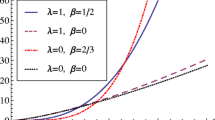Abstract
The model of the gravitationally neutral Universe (GNU), i.e., a giant but finite 3D Ball expanding in the infinite static Euclidean space, is considered. The model is based on the antigravitation between particles and antiparticles. The GNU Ball is filled equally by matter and antimatter clusters and freely expands after epochs of partial annihilation and recombination. The abandonment of the cosmological principle and the problem of our Galaxy position in the GNU Ball are discussed.
Similar content being viewed by others
References
Planck Collaboration, “Planck 2013 Results. XVI. Cosmological Parameters,” arXiv:1303.5076 astroph. CO. (2013).
L. Perivolaropoulos, “Large Scale Cosmological Anomalies and Inhomogeneous Dark Energy,” arXiv:1401.5044 v1 astro-ph.CO. (2014).
A. Einstein, Sitzungsberichte der Königlich Preussischen Akademie der Wissenschaften (Berlin), Sitzung der Physikalisch-Mathematischen Klasse, 142 (1917).
A. Friedmann, Die Welt als Raum und Zeit. Ostwalds Klassiker der Exakten Wissenschaften, Band 287, (1923).
A. Benoit-Levy and G. Chardin, Astron. Astrophys. 537, 1 (2012).
A. D. Chernin, P. Teerikorpi, M. J. Valtonen, et al., “Dark Energy and the Mass of the Local Group,” arXiv: 0902.3871v1 astro-ph.CO. (2009).
I. A. Gribov and S. A. Trigger, “Jeans Instability and Antiscreening in Gravitational-Antigravitational Model of Universe,” http://arxiv:1404.7122 (2014)
S.A. Trigger, I.A. Gribov, J. Phys.: Conf. Series 653, 012121 (2015).
S. A. Trigger, “Cold Dark Matter and Dark Energy in Universe: Possible Anisotropy of the Earth Observations,” Book of Abstracts XXX International Conference “Interaction of Intense Energy fluxes with Matter,” Elbrus, Kabardino-Balkaria, Russia, 2015 (IIEFM, Elbrus, 2015), p. 208.
I. A. Gribov, “From the Waveguided Gravity to the Periodic Waveguided Multiverse as United Solution of Dark Energy and DarkMatter, SUSY - Mysteries,” http://vixra.org: 1304.0135v1 (2013).
S. Perlmutter, et al., Astrophys. J. 517, 565 (1999).
A. G. Riess, B. P. Schmidt, et al., Astron. J. 116, 1009 (1998).
A. Guth, Phys. Rev. D 23, 347 (1981).
R. Watkins, H. A. Feldman, and M. J. Hudson, Mon. Not. R. Astron. Soc. 392, 743 (2009); Galaxies 2, 55 (2014).
A. Kashlinsky, F. Atrio-Barandela, D. Kocevski, and H. Ebeling, Astrophys. J. 686, L49 (2008).
F. Atrio-Barandela, A. Kashlinsky, H. Ebeling, et al., “Probing the Dark Flow Signal in WMAP 9 yr and PLANCK CosmicMicrowave BackgroundMaps,” http://arxiv: 1411.4180 (2014).
H. Alfven, J. Astrophys. Astron. 5, 79 (1984).
B. A. Klumov and S. A. Trigger (private communication, to be published in 2015).
L. I. Schiff, Phys. Rev. Lett. 1, 254 (1958).
P. A. R. Ade et al., Phys. Rev. Lett. 114, 101301 (2015).
R. Adam, et al., “Planck Intermediate Results. XXX. The Angular Power Spectrum of Polarized Dust Emission at Intermediate and High Galactic latitudes - Planck Collaboration,” arXiv:1409.5738. astroph. CO. (2014).
G. B. Andresen et al., Nat. Phys. 7, 55 (2011).
S. Aghion et al., “(AEgIS Collaboration) Prospects for Measuring the Gravitational Free-Fall of Antihydrogen with Emulsion Detectors,” http://arXiv:1306.5602 (2013).
G. Chardin et al., Preprint CERN-SPSC-2011-029/SPSC-P-342 (2011).
Author information
Authors and Affiliations
Corresponding author
Additional information
Original Russian Text © S.A. Trigger, I.A. Gribov, A.A. Rukhadze, 2015, published in Kratkie Soobshcheniya po Fizike, 2015, Vol. 42, No. 12, pp. 43–49.
About this article
Cite this article
Trigger, S.A., Gribov, I.A. & Rukhadze, A.A. Cosmological consequences of the particle-antiparticle gravitational repulsion hypothesis: the Newtonian model of the universe. Bull. Lebedev Phys. Inst. 43, 1–4 (2016). https://doi.org/10.3103/S1068335616010012
Received:
Published:
Issue Date:
DOI: https://doi.org/10.3103/S1068335616010012




